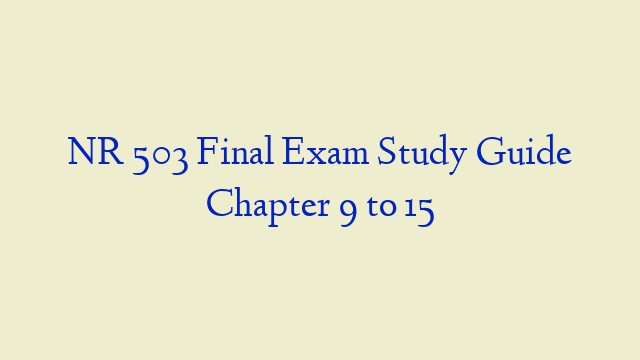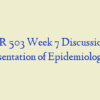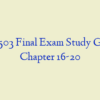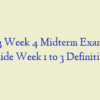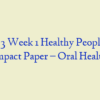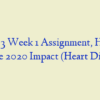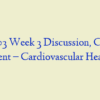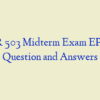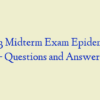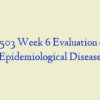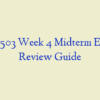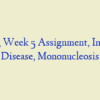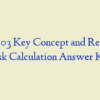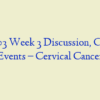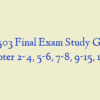Description
NR 503 Final Exam Guide
- A study is planned to investigate the relationship of factors associated with maternal hypertension and the risk of congenital birth defects in children born to these women. Which of the following would be a reason for using a cohort study design?
- A researcher is interested in the etiology of myocardial infarction (MI) among men between 18 and 40 years of age. Her hypothesis concerns the influence of diets high in fat and subsequent development of MI. What is the best study approach to address this hypothesis?
- Which of the following is an advantage to the conduct of a cohort study?
- A cohort study is planned to investigate the potential adverse health effects of daily alcohol consumption. In assessing the risk of liver cancer related to alcoholism, which of the following is not an important methodologic consideration?
Which of the following is not an advantage of a retrospective cohort study? - In a study of the adverse effects of x-rays among children, a retrospective cohort study was done using records from several large children’s hospitals for the period of 1980 to 1985. 10,000 children were selected as a representative population of ill children seen at the hospitals during that time. Subjects were classified according to whether or not they received an x-ray during their stay in the hospital and were followed from their hospital stay through 2005 for the development of cancer. During the follow-up period, 49 incident cancers occurred in 3,263 children who had received an x-ray, and 47 incident cancers occurred in the 6,737 children who had not received an x-ray during their hospitalization. In this retrospective study, which of the following groups are eligible for selection into the study?
- In a study of the adverse effects of x-rays among children, a retrospective cohort study was done using records from several large children’s hospitals for the period of 1980 to 1985. 10,000 children were selected as a representative population of ill children seen at the hospitals during that time. Subjects were classified according to whether or not they received an x-ray during their stay in the hospital and were followed from their hospital stay through 2005 for the development of cancer. During the follow-up period, 49 incident cancers occurred in 3,263 children who had received an x-ray, and 47 incident cancers occurred in the 6,737 children who had not received an x-ray during their hospitalization. What are the rates of cancer incidence in each exposure group?
- In a study of the adverse effects of x-rays among children, a retrospective cohort study was done using records from several large children’s hospitals for the period of 1980 to 1985. 10,000 children were selected as a representative population of ill children seen at the hospitals during that time. Subjects were classified according to whether or not they received an x-ray during their stay in the hospital and were followed from their hospital stay through 2005 for the development of cancer. During the follow-up period, 49 incident cancers occurred in 3,263 children who had received an x-ray, and 47 incident cancers occurred in the 6,737 children who had not received an x-ray during their hospitalization. What is the attributable risk of cancer due to x-ray in this study population? What is the interpretation of this estimate?
- In a study of the adverse effects of x-rays among children, a retrospective cohort study was done using records from several large children’s hospitals for the period of 1980 to 1985. 10,000 children were selected as a representative population of ill children seen at the hospitals during that time. Subjects were classified according to whether or not they received an x-ray during their stay in the hospital and were followed from their hospital stay through 2005 for the development of cancer. During the follow-up period, 49 incident cancers occurred in 3,263 children who had received an x-ray, and 47 incident cancers occurred in the 6,737 children who had not received an x-ray during their hospitalization. What is the risk ratio for the effect of exposure on the development of cancer in this study? What is the interpretation of this estimated ratio?
- In a study of the adverse effects of x-rays among children, a retrospective cohort study was done using records from several large children’s hospitals for the period of 1980 to 1985. 10,000 children were selected as a representative population of ill children seen at the hospitals during that time. Subjects were classified according to whether or not they received an x-ray during their stay in the hospital and were followed from their hospital stay through 2005 for the development of cancer. During the follow-up period, 49 incident cancers occurred in 3,263 children who had received an x-ray, and 47 incident cancers occurred in the 6,737 children who had not received an x-ray during their hospitalization. Which of the following issues should the investigators consider when interpreting whether a causal association exists between cancer incidence and childhood x-ray?
- Which of the following may be a factor that would result from the inability to use randomization in a cohort study?
Question: 6,750 people who were free of disease X were enrolled in a cohort study in 1985 and followed with annual exams and interviews through 1995. Exposure to factor A was determined at study enrollment and the participants were followed until 1995 to observe new cases of disease X. Data from the study at the end of follow-up are shown in the following table. What is the incidence rate of disease X among persons exposed to factor A? - 6,750 people who were free of disease X were enrolled in a cohort study in 1985 and followed with annual exams and interviews through 1995. Exposure to factor A was determined at study enrollment and the participants were followed until 1995 to observe new cases of disease X. Data from the study at the end of follow-up are shown in the following table. What is the relative risk for the effect of exposure to factor A on disease X?
- In 2002, investigators started a study of the association of cholesterol levels and stroke in a group of 2,000 healthy persons who had participated in a cholesterol screening program in 1992. The investigators determined exposure categories using cholesterol levels in all persons that were measured at the time of the screening program. A cutoff value of 200 mg/dL was used to define “high” cholesterol while those with levels below 200 were identified as having “low” cholesterol. Using this definition, 1,000 persons had “high” cholesterol levels while the remaining 1,000 persons had “low” cholesterol. The investigators determined that 150 cases of stroke occurred by the end of 2004, with 113 cases occurring in the high cholesterol group. What is the study design that the investigators used?
- In 2002, investigators started a study of the association of cholesterol levels and stroke in a group of 2,000 healthy persons who had participated in a cholesterol screening program in 1992. The investigators determined exposure categories using cholesterol levels in all persons that were measured at the time of the screening program. A cutoff value of 200 mg/dL was used to define “high” cholesterol while those with levels below 200 were identified as having “low” cholesterol. Using this definition, 1,000 persons had “high” cholesterol levels while the remaining 1,000 persons had “low” cholesterol. The investigators determined that 150 cases of stroke occurred by the end of 2004, with 113 cases occurring in the high cholesterol group. What type of risk measure should the investigators calculate?
- In 2002, investigators started a study of the association of cholesterol levels and stroke in a group of 2,000 healthy persons who had participated in a cholesterol screening program in 1992. The investigators determined exposure categories using cholesterol levels in all persons that were measured at the time of the screening program. A cutoff value of 200 mg/dL was used to define “high” cholesterol while those with levels below 200 were identified as having “low” cholesterol. Using this definition, 1,000 persons had “high” cholesterol levels while the remaining 1,000 persons had “low” cholesterol. The investigators determined that 150 cases of stroke occurred by the end of 2004, with 113 cases occurring in the high cholesterol group. Using the reported study data, what is the estimate of the risk measure that was chosen?
- In 2002, investigators started a study of the association of cholesterol levels and stroke in a group of 2,000 healthy persons who had participated in a cholesterol screening program in 1992. The investigators determined exposure categories using cholesterol levels in all persons that were measured at the time of the screening program. A cutoff value of 200 mg/dL was used to define “high” cholesterol while those with levels below 200 were identified as having “low” cholesterol. Using this definition, 1,000 persons had “high” cholesterol levels while the remaining 1,000 persons had “low” cholesterol. The investigators determined that 150 cases of stroke occurred by the end of 2004, with 113 cases occurring in the high cholesterol group. What is a necessary assumption for the study’s findings to be true?
- The following data are from a prospective study that examined the relationship between smoking and incidence of both myocardial infarction (heart attack) and breast cancer among women. What is the proportion attributable risk of breast cancer among smokers?
- The following data are from a prospective study that examined the relationship between smoking and incidence of both myocardial infarction (heart attack) and breast cancer among women. What is the proportion attributable risk of breast cancer among smokers? What is the relative risk of myocardial infarction for smokers?
- The following data are from a prospective study that examined the relationship between smoking and incidence of both myocardial infarction (heart attack) and breast cancer among women. If the proportion of smokers in this population is 30%, what is the population proportion attributable risk of breast cancer due to smoking?
- A researcher is interested in the etiology of cervical cancer among women between 18 and 35 years of age. Her hypothesis concerns the influence of sexually transmitted diseases such as human papilloma virus (HPV) and subsequent development of cancer. What is the best study approach to address this hypothesis?
- Suppose that 350 cervical cancer cases were identified and a random sample of women of the same age range who were admitted to the hospital included 500 eligible controls. After independent blood tests of all cases and controls, 90% of cases were positive for HPV antibodies while 63% of controls were positive for antibodies to the virus. What is the appropriate ratio measure of association and its value?
- Suppose that one third of all cervical cancer cases were smokers as were one third of all controls and smoking status is independent of HPV infection. Is smoking a potential confounder in this study?
- A case-control study was conducted to determine if an association exists between workers in uranium mines and loss of fertility due to reduced sperm count. A group of 200 men with low sperm count were identified from clinics located in areas with uranium mines. Each selected case was matched with a randomly selected male control on the following factors: race, age, area of residence, and smoking status. What is the purpose of matching?
- The following numbers of matched pairs were reported: 4 matched pairs in which both men worked in a uranium mine, 9 pairs in which the case had mine exposure but the control did not, 2 pairs in which the case had no mine exposure but the control did, and 185 pairs in which neither man had worked in a uranium mine. What is the odds ratio for reduced sperm count among the uranium miners?
- A case-control study of the relationship between high-fat diet and diabetes was performed. The results of the study are shown below, stratified by gender. What is the crude odds ratio for the association between high-fat diet and diabetes in this study?
- A case-control study of the relationship between high-fat diet and diabetes was performed. The results of the study are shown below, stratified by gender. What is the odds ratio among men only?
- A case-control study of the relationship between high-fat diet and diabetes was performed. The results of the study are shown below, stratified by gender. What is the odds ratio among women only?
- A case-control study of the relationship between high-fat diet and diabetes was performed. The results of the study are shown below, stratified by gender. Based on the responses above, what is the most appropriate measure of association to present when reporting the results of this study?
- A case-control study of the relationship between high-fat diet and diabetes was performed. The results of the study are shown below, stratified by gender. Which of the following is demonstrated by the stratified odds ratio shown above?
- When incidence density sampling is used in a case-control study, which of the following is an important consideration?
- A recent prospective study on baldness and coronary heart disease (CHD) concluded that there was no association between the two, despite earlier cross-sectional studies which showed that baldness was associated with CHD when the two were determined at the same time in men. Which Bradford-Hill criterion is being tested by the newer study?
- A study examined the relation between use of estrogen replacement therapy (ERT) and ovarian cancer mortality using a prospective design. Of 24,231 eligible women, none had a prior history of cancer, hysterectomy, or ovarian surgery at enrollment in 1982. During 12 years of follow-up, 44 deaths from ovarian cancer occurred. In the published results, the authors note that 12,543 were excluded from the original cohort due to missing information for prior history variables. Which of the following is of greatest concern when interpreting the study results?
- A study examined the relation between use of estrogen replacement therapy (ERT) and ovarian cancer mortality using a prospective design. Of 24,231 eligible women, none had a prior history of cancer, hysterectomy, or ovarian surgery at enrollment in 1982. During 12 years of follow-up, 44 deaths from ovarian cancer occurred. In the published results, the authors note that 12,543 were excluded from the original cohort due to missing information for prior history variables.
Age at menopause is a potential factor associated with use of ERT. The study investigators created three categories for age at menopause: less than 45 years, 46 through 54 years, and 55 years or more. After stratifying on age at menopause, the researchers reported relative risks of 0.97, 1.00 (referent), and 0.93 for each age group, respectively. Which of the following is true? - A case-control study was conducted to assess whether occupational radiation exposure among men was associated with Down syndrome in their children. The investigators matched cases and controls on age of the mother at childbirth by 5-year categories. Why was this done?
- A case-control study was …to assess whether occupational radiation exposure among men was associated with Down syndrome in their children. The investigators match cases and controls on age of the mother at childbirth by 5-year categories. When possible, information on paternal radiation exposure was ….from employment records rather than from subject interviews. Why was this done?
- An epidemiologist was …in determining whether aspirin was ….with an increased risk of gastrointestinal (GI) bleeding. She …on primary physicians to identify 600 patients at a hospital who were taking a daily dose of aspirin and 600 other patients who were not taking aspirin. Subjects were followed for 1 year to detect any occurrences of GI bleeding. Due to publicity about the risk of bleeding associated with aspirin, primary physicians treating patients at the hospital followed their patients who were taking aspirin more closely than they were unexposed subjects. Which of the following describes the impact that this may have on the epidemiologist’s study?
- An epidemiologist was interested in determining whether aspirin was associated with an increased risk of gastrointestinal (GI) bleeding. She relied on primary physicians to identify 600 patients at a hospital who were taking a daily dose of aspirin and 600 other patients who were not taking aspirin. Subjects were followed for 1 year to detect any occurrences of GI bleeding. Due to publicity about the risk of bleeding associated with aspirin, primary physicians treating patients at the hospital followed their patients who were taking aspirin more closely than they were unexposed subjects.
- Suppose that the study was repeated with a second physician who was responsible for verifying a diagnosis of GI bleeding in the patients. This physician was informed that all patients were using aspirin. If the likelihood of diagnosing the outcome among unexposed subjects was increased while all other diagnostic probabilities remained the same, what impact would this have on the bias?
- Matching is employed in a case-control study in order to ensure that:
- The effect of exposure to high-density automobile traffic either as a bicyclist or pedestrian was compared to minimal or no exposure to automobile traffic. It is hypothesized that direct exposure to automobile traffic has an effect on acute myocardial infarction (MI). This association was studied with 500 incident cases of MI diagnosed in the emergency rooms of several hospitals and compared to 1,000 other subjects who visited the same emergency rooms for reasons other than cardiovascular and respiratory diseases. All subjects were asked to report the amount of time that they spent exposed to high-density traffic over the past month prior to their hospital visit.
What type of study design is this? - The effect of exposure to high-density automobile traffic either as a bicyclist or pedestrian was compared to minimal or no exposure to automobile traffic. It is hypothesized that direct exposure to automobile traffic has an effect on acute myocardial infarction (MI). This association was studied with 500 incident cases of MI diagnosed in the emergency rooms of several hospitals and compared to 1,000 other subjects who visited the same emergency rooms for reasons other than cardiovascular and respiratory diseases. All subjects were asked to report the amount of time that they spent exposed to high-density traffic over the past month prior to their hospital visit.
After completing the recruitment, the investigators compiled their data in the following table:Using the appropriate measure of association, as compared to the group with no traffic exposure, which of the following is a true statement concerning MI? - The effect of exposure to high-density automobile traffic either as a bicyclist or pedestrian was compared to minimal or no exposure to automobile traffic. It is hypothesized that direct exposure to automobile traffic has an effect on acute myocardial infarction (MI). This association was studied with 500 incident cases of MI diagnosed in the emergency rooms of several hospitals and compared to 1,000 other subjects who visited the same emergency rooms for reasons other than cardiovascular and respiratory diseases. All subjects were asked to report the amount of time that they spent exposed to high-density traffic over the past month prior to their hospital visit.
Which of the following may explain the reason for the observed association? - Which of the following is an advantage of the case-control study design?
- In a published epidemiologic study investigating infertility related to sexually transmitted diseases (STD), the authors state that 5% of identified cases refused enrollment, 10% of identified cases were lost to follow-up prior to data collection, and 10% of interviewed cases had missing data for one or more key variables describing exposure. Based on this information, which of the following statements is most likely to be true?
- A large case-control study using multiple recruitment centers was conducted comparing 2,987 lung smoker cases to 3,013 other hospitalized persons selected as controls. One objective was to study the association between occupational exposure to chemicals and lung cancer. After compiling the data, the investigators noted that 90% of persons with lung cancer were smokers while 67% of the controls were smokers. The most practical and efficient way to eliminate differences between the cases and controls with regard to smoking would be to:
- An investigator is interested in studying the adverse effects of exposure to toxic metals on neurologic diseases such as Alzheimer’s disease. In assessing this risk, all of the following are important considerations for a prospective study design except:
- A history of dietary supplement with calcium was recorded among 10,000 women over the age of 50. The women were followed for 2 years to determine if they experienced hip fracture. Calcium supplementation was reported by 31% of women who experienced hip fracture and by 46% of all other women. In a case-control study with equal numbers of cases and controls, what is the number of women with a hip fracture who are not taking calcium supplements?
- A history of dietary supplement with calcium was recorded among 10,000 women over the age of 50. The women were followed for 2 years to determine if they experienced hip fracture. Calcium supplementation was reported by 31% of women who experienced hip fracture and by 46% of all other women. What are the odds of a hip fracture among women who are taking calcium supplements?
- A history of dietary supplement with calcium was recorded among 10,000 women over the age of 50. The women were followed for 2 years to determine if they experienced hip fracture. Calcium supplementation was reported by 31% of women who experienced hip fracture and by 46% of all other women. What is the measure of association between calcium supplementation and hip fracture?
- In a study of 100 cases of colon cancer in women, there were 200 age- and race-matched controls. The suspected etiologic factor was higher-than-average consumption of red meat. The absolute risk of colon cancer in persons with this level of consumption is:
- Why are controls needed in a case-control study?
- When is odds ratio obtained in a case-control study a reliable approximation of the relative risk for the general population?
- A published epidemiologic study investigating infertility related to sexually transmitted diseases (STD), the authors state that 5% of identified cases refused enrollment, 10% of identified cases were lost to follow-up prior to data collection, and 10% of interviewed cases had missing data for one or more key variables describing exposure.
– In the primary analysis of the study, the investigators measured exposure as a dichotomous variable (any history of STD compared to no history of STD). In subsequent analyses, the investigators looked at the relationship between specific STDs and infertility. They noted the following measures of association: for past history of gonorrhea, the odds ratio was 2.4 with a 95% confidence interval of 1.3 to 4.4. For past history of chlamydia, the odds ratio was 1.8 with a 95% confidence interval from 1.2 to 2.1. These results indicate that: - If an investigator is analyzing the results of a clinical trial, then applying the “intention to treat” rule means that which type of bias is most likely to result?
- After data were gathered for the study, the investigators decided to restrict the analysis to women only, rather than including both men and women in the study. Assuming that sex is a confounder of the exposure–disease relationship under investigation, this decision would have which of the following effects?
- Investigators wanted to know if some military personnel are more error prone than others and would be a poor risk for training as a pilot. A study was ….in which individuals who had injuries during basic training were compared to individuals who had not had an injury during training. Both groups were ….to recall episodes during childhood when they had had accidents that resulted in an injury. The individuals with a training injury ….more incidents during childhood when they had an injury. Therefore, the military command conclude that some persons are more likely to be error prone and that individuals with a childhood injury should be …from pilot training.
One commanding officer disagree with this conclusion. He ask the investigators to design a second study in which all individuals were …about childhood injuries prior to the start of basic training. The group who ….having a childhood injury was compare to the group. Who had not had a childhood injury to determine which group had a higher rate of injuries during basic training. At the end of follow-up, there was no difference in the rate of injuries experienced by each group.
What type of design was used for the first study? - Investigators want to know if some military personnel are more error prone than others and would be a poor risk for training as a pilot. A study was ….in which individuals who had injuries during basic training were compare to individuals who had not had an injury during training. Both groups were ….to recall episodes during childhood when they had had accidents that result in an injury. The individuals with a training injury report more incidents during childhood when they had an injury. Therefore, the military command conclude that some persons are more likely to be error prone and that individuals with a childhood injury should be excluded from pilot training.
– One commanding officer disagreed with this conclusion. He asked the investigators to design a second study in which all individuals were asked about childhood injuries prior to the start of basic training. The group who reported having a childhood injury was compared to the group who had not had a childhood injury to determine which group had a higher rate of injuries during basic training. At the end of follow-up, there was no difference in the rate of injuries experienced by each group.
What type of study design was used for the second study? - Investigators wanted to know if some military personnel are more error prone than others and would be a poor risk for training as a pilot. A study was done in which individuals who had injuries during basic training were compared to individuals who had not had an injury during training. Both groups were asked to recall episodes during childhood when they had had accidents that resulted in an injury. The individuals with a training injury reported more incidents during childhood when they had an injury. Therefore, the military command concluded that some persons are more likely to be error prone and that individuals with a childhood injury should be excluded from pilot training.
– One commanding officer disagreed with this conclusion. He asked the investigators to design a second study in which all individuals were asked about childhood injuries prior to the start of basic training. The group who reported having a childhood injury was compared to the group who had not had a childhood injury to determine which group had a higher rate of injuries during basic training. At the end of follow-up, there was no difference in the rate of injuries experienced by each group.
– Which study better tests the hypothesis that there is a relationship between childhood injury and subsequent injury during basic training? - Investigators wanted to know if some military personnel are more error prone than others and would be a poor risk for training as a pilot. A study was done in which individuals who had injuries during basic training were compared to individuals who had not had an injury during training. Both groups were asked to recall episodes during childhood when they had had accidents that resulted in an injury. The individuals with a training injury reported more incidents during childhood when they had an injury. Therefore, the military command concluded that some persons are more likely to be error prone and that individuals with a childhood injury should be excluded from pilot training.
- One commanding officer disagreed with this conclusion. He asked the investigators to design a second study in which all individuals were asked about childhood injuries prior to the start of basic training. The group who reported having a childhood injury was compared to the group who had not had a childhood injury to determine which group had a higher rate of injuries during basic training. At the end of follow-up, there was no difference in the rate of injuries experienced by each group.
– Which of the following may explain why the two studies observed different results concerning the association between childhood injury and training injury? - In a study of oral contraceptive (OC) use and hypertension, male interviewers for the study found a lower prevalence of OC use among participants than did female interviewers using the same questionnaire. Which term best describes this finding?
- A matched case-control study of sunscreen use during childhood and melanoma results in an odds ratio of 1.0. Cases of melanoma were match by sex and race to controls who were ….by random digit dialing. What is the most likely explanation for the study’s null finding?
- Among patients with liver cancer, current alcohol drinkers have a worse prognosis for survival than nondrinkers. What would be the impact on the odds ratio for a case-control study of current alcohol use and liver cancer mortality if prevalent cases were include with incident cases of the cancer?
- In a cohort study, the reported relative risk was 2.0; however, the investigators concluded that the study likely had a bias away from the null hypothesis. But they concluded that an association did exist between the exposure and the outcome. The true relative risk is most likely:
- In a case-control study of maternal cigarette smoking as a risk factor for low birth weight. The investigators concluded that mothers of children with low birth weight were more likely to report smoking during pregnancy relative to mothers of children with normal birth weight. The reporting error most likely caused the odds ratio to:
- In a case-control study of obesity and adult-onset asthma, controls are match to cases on the basis of race and gender. This approach to selection is ….to decrease the influence of which type of bias?
- In a case-control study of computer display exposure and glaucoma, cases and controls were also ask about television watching habits. Errors in recall of exposure to video screens ….with equal frequency among cases and controls. Which one of the following biases likely occur?
- In a case-control study of computer display exposure and glaucoma, cases and controls were also …about television watching habits. Errors in recall of exposure to video screens ….with equal frequency among cases and controls. What is the most likely effect of this bias on the measure of association report by the study?
- In a case-control study of computer display exposure and glaucoma, cases and controls were also ask about television watching habits. Errors in recall of exposure to video screens occur with equal frequency among cases and controls. Which of the following methods for adjusting for confounding by age is most likely to affect the generalizability of the study findings?
- In a cohort study of occupational exposure to a chemical and subsequent incidence of bladder cancer. All workers who smoke were more likely to die of other causes before bladder cancer was diagnose. What was the effect of this premature mortality on the measure of association reported by the study?
- Which of the following statements about person-years is not true?
